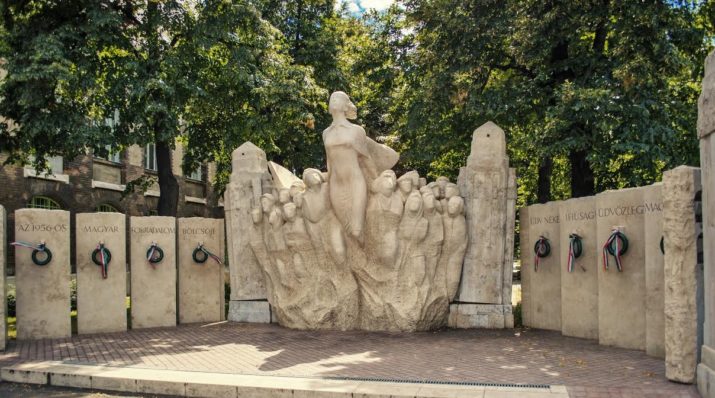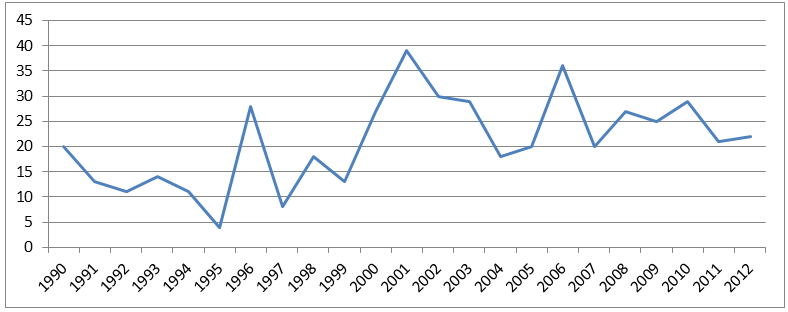

This is part of our special feature, Contemporary Urban Research in the European City.
Following the year of 1993, when several socialist statues were relocated to a designated Statue Park in Budapest, the previous memory-scape of the city considerably changed; partly remaining visible, partly disappearing. Yet, while the coming and going of public works of art belongs to the general experiences of cities, “presence” and “absence” also came to symbolize the essential characteristics of memory politics in Budapest after 1989.
For a relatively long time, the understanding of the concept of presence and absence was determined along the lines of a mutually exclusive relationship: in classical philosophy (see Plato’s allegory of the cave) presence got associated with a true being, i.e., with absolute truth, whereas absence got connected to the illusion of an appearance, i.e., to imitation. This reciprocal interpretation got challenged, first, by the separate theories of presence and absence (see e.g., George Bataille’s theory of “excess” or Jacques Lacan’s notion of “lack”), then by the unification of the two terms. In postmodern philosophy, (see most importantly the writings of Jacques Derrida), absence came to be thought of as a kind of excess, whereas excess was turned into a kind of absence. Examining various public works of art in Budapest after 1989, I will similarly argue that absence and presence do intertwine in the Hungarian memory politics, too.
From Absences to Excesses
Amidst the reposition of the socialist heritage of Budapest after the regime change, serious doubts emerged considering the future legitimacy of public memorials. Even though, during the 80s, art historian Lajos Németh (cited in Mélyi 2008) already suggested giving up the practice of erecting public statues, the idea could gain a real articulation only at the dawn of the regime change. In 1989, art historian Tibor Wehner published a paper in the journal Folyam, in which he verbalized a powerful manifesto for the new political period. In Memorials of Absence (A hiány emlékművei), he argued that:
Instead of repetition, this period could create its own self-image and it could leave traces for posterity if it did not erect statues and memorials. It could produce an appropriate image of its time through the display of emptiness and through the production of tracelessness. Referring to the so-called progressive traditions through the artificially (…) created pure nothing (…) it would build the modest memorial of the absence. (…) Its spaces could expand and clarify [my translation].
Wehner, thus, proposed to use the notion of absence as a basis of the new political era’s memory politics. But how is it to be understood? Is Wehner calling for the non-erection of memorials?
In the immediate years before the end of the Cold War, the yearly number of erecting public works of art in Budapest radically started to diminish. While during the 80s this number could even reach 50, it has dropped to ca. 20 by 1989.

Figure 1. The yearly erection of public works of art in Budapest after 1989[1]
As Figure 1 shows, in the beginning of the new political period, the number of public works of art installed in Budapest indeed continued to decrease. Yet, even though the early low-keyed installation of public works of art in Budapest is a tell-tale sign in itself, this tendency can partly be put down to the city’s preoccupation with finding and defining the status of their own socialist heritage. What happened, however, after 1993, when the official opening ceremony of the Statue Park took place? Interestingly enough, after the first years of the regime change the number of public works of art in Budapest started to increase. Why?
In contrast to the example of Berlin that not only became to function as a model of mastering the past (see the notion of “Vergangenheitsbewältigung”), but also elaborated an aesthetic program based on the concept of absence (see most importantly Young’s notion of “counter monuments”[2]), in Hungary political authorities remained puzzled over how to react to the challenges and potentials of the new era, which in turn resulted in the emergence of multiple and fragmented memory narratives giving also rise to a conceptual and stylistic cacophony of memorials. This process of dissolving memory narratives and diverging aesthetics ad absurdum affected mostly those works of art that commemorated the 1956 Revolution—the revolution, which was a nationwide uprising against the Soviet occupation and rule of Hungary between October 23 October and November 10, and which came to symbolize the par excellence moment of national unity.
In the immediate period after the regime change, there were already visible signs of the overrepresentation of 1956. In June 1992, the National Association of Hungarians and the Committee of Justice for Martyrs erected a so-called Székely gate only a couple of meters away from György Jovánovics’ Memorial of the Martyrs of the 1956 Revolution in the New Public Cemetery, inaugurated by the Committee for Historical Justice a few days later. The two works couldn’t be any more different from each other. While the Székely gate (a carved, ornamental wooden gate characteristic of rural Transylvania) fitted into the tradition of folk architecture, the Memorial of the Martyrs of the 1956 Revolution appeared in the form of a highly innovative aesthetics typical of counter-monuments. The former, through its inscription,[3] evoked the idea of a “National(ized) Pantheon.” The latter, with its creator coming from the avant-garde scene, consciously distanced itself from a nineteenth-century tradition, and functioned as a conceptual piece. The Memorial of the Martyrs of the 1956 Revolution consist of three symbolic elements: (1) an open grave with a black pillar exactly 1956 millimeters high that is sank below the ground, (2) a path leading to a white altar-like structure, and (3) a great rustic stone behind it. While aesthete László Földényi F. (1992) interprets this structure simultaneously as a metaphor of the journey of the human body[4] and as a representation of the history of plastic art,[5] art historian András Rényi (n.d.) argues that the various parts of the memorial are all plastic simulacra.[6] In both readings Jovánovics plays with the notions of materiality and immateriality, and with the concepts of presence and absence.
At the same time, it was not only the form of the Székely gate and Jovánovics’ memorial that differed to a great extent. The historical narratives mediated through the two works radically diverged, too. In the case of the Székely gate the initiators (who were close to far right ideologies), as well as the rustic design (native to Transylvania[7]) suggested a continuity between the revisionist nationalism of the inter-war years and the revolution of 1956 (György 2000:312, K. Horváth 2008:260). In contrast, Jovánovics (1994) strongly emphasized that the Memorial of the Martyrs of the 1956 Revolution was not a political work of art, but an artistic elaboration of the notion of death, or, as Földényi (1992) refers to it, a “thanato-plastic.”
Similarly to the parallel narratives and forms of the memory of the 1956 Revolution in the New Public Cemetery, Kossuth Square also accommodated multiple works of art commemorating the Uprising. In 1991, the World Association of 56er Hungarians placed László Gömbös and Imre Makovecz’s Memorial of the Victims of the Firing Squad on October 25, 1956 illegally on the south lawn of the Kossuth Square. In 1996, on the 40th anniversary of the events of 1956, the Institute of the History of 1956 and the 1956 Memorial Committee erected Mária Lugossy’s The Flame of the Revolution north of the entrance to the Hungarian Parliament. In the same year, the Imre Nagy Memorial Foundation inaugurated Tamás Varga’s Statue of Imre Nagy in a visible distance from the Kossuth Square. In 2002, the Ministry of Agriculture and Rural Development installed József Kampfl and Ferenc Callmeyer’s Memorial of the Victims Died in the Volley on October 25, 1956 on the wall of the Ministry opposite the building of the Parliament. All four memorials operated with extremely different visual languages. Gömbös and Makovecz’s memorial appeared as a symbolic grave with a repeatedly changing informational table that articulated a strong anti-communist message. József Kampfl and Ferenc Callmeyer commemorated the same event in a memorial sign that revealed the wounds of the building of the Ministry through marking the place of the bullets with bronze bullet-like balls. Although these two memorials already in themselves illustrate the aesthetic diversity of the square, both The Flame of the Revolution and the Statue of Imre Nagy introduced further stylistic traditions. Lugossy’s abstract representation created a clear contrast to Varga’s figural representation of Nagy: while the former was a black granite block through which there was an eternal flame burning, Varga depicted the 1956 Chairman of the Council of Ministers of the People’s Republic of Hungary in a romantic setting, standing on a bridge. Nineteenth-century traditional configurations, experimental forms, abstract elaborations, and genre statues; the memory of the 1956 Revolution was irreversibly falling apart. This disintegration, however, reached its zenith in 2006.
Surpassing the objects of the annual celebrations, in 2006, on the 50th anniversary of the 1956 Hungarian Revolution and War of Independence, the socialist government undertook the mission to create a new commemorational space, to design the central 1956 Memorial. Although the whole program was carried out under the slogan “1956 is our common history,” its main aim to give a collective framework to memories concerning 1956, failed miserably. Referring to aesthetical, ideological, and after all political disapprovals, the Prime Minister’s Office’s winning entry became boycotted by the Association of Freedom Fighters 1956 who not only did get backed up by right wing political parties, but also forced the parallel erection of another memorial. Even though both monuments intend to symbolize an increasing mass of revolutionaries, their forms stand in a sharp contrast to each other. While the winning entry—standing at Ötvenhatosok tere – has an abstract form and resembles a wedge, the other memorial—erected on Műegyetem rakpart – is a more classical, figural representation and recalls the 19th century, romantic composition of Delacroix’s Freedom Guiding the People. The simultaneous existence of two “central” monuments does not only shed light on the competing presence of contradictory memory narratives and forms, but it also reveals the polarization of the urban space in Budapest along the lines of left-wing and right-wing party preferences. In this sense, in Budapest the growing tendency of erecting public works of art after 1993 illustrates the existence of a multi-narrative and multi-aesthetic approach: the excess of political and aesthetic visions.

From Excesses to Absences
After the year 2000, the number of works per annum was still steadily growing in Budapest, yet, the increasing tendency of the installation of public works of art got coupled with a noticeable crisis. In 2006 House of Terror[8] organized a permanent exhibition on the facade of its building that displayed the portrait of 228 people executed in 1956. At a first sight, the Wall of Heroes, designed by Attila Kovács F., offered a traditional heroic interpretation of the revolution. The oval form, the material of porcelain and the black framing of the pictures did not only evoke the aesthetics of graveyards, but the glorification-like background of persons also transformed freedom fighters into saints. Yet, as Boros (2007) notes, this reading has been strongly disturbed by another strategy. Even though according to the concept of Kovács F. the portraits were indeed supposed to include the name and profession of the particular revolutionaries, in the case of Imre Nagy, Miklós Gimes and Géza Losonczy, who have all been ceremonially rehabilitated and reburied in 1989 on the Heroes’ Square, there was an attribute put aside to their professions, too. As their inscriptions reported, they have been “communist politicians.” And being a communist, especially in the context of the House of Terror, is in itself a swear-word. Thus, this insertion did not only aim to diminish the martyrdom of Nagy, Gimes and Losonczy, but also revealed that some aspects of the memory of the 56 Revolution started to become overly uncomfortable for the right wing whose political creed has been placed more and more openly on a strong anti-communist rhetoric.
After 2010, when Fidesz won the two-third majority of the elections, the principle of anti-communism has also been codified. According to the new Constitution enacted in 2012, the German occupation in 1944 signalled the loss of self-determination of Hungary, which was only restored with the collapse of socialism in 1990. However, if the period between 19 March 1944 and 2 May 1990 becomes erased, what happens to the memory of 1956? Even though the Preamble also declares that “We agree with the Members of the first free National Assembly, which proclaimed as its first decision that our current liberty was born of our 1956 Revolution,” there was a sensible unease growing considering its current position in collective memory, as well as in the urban space. This discomfort was further strengthened when in 2011 the Hungarian government, as a material consequence of the Constitution, instructed the renovation of Kossuth Square in accordance with its pre-1944 appearance. In this sense, all the statues that have been erected after 1944–including the various, already outlined, 56 memorials–were to be replaced with their predecessors from before 1944. It is as if the memory of the Hungarian Revolution of 1956 had no longer a place on the new “Main Square of the Nation.” While due to the pressure of businessman Sándor Demján Tamás Varga’s Statue of Imre Nagy (1996) finally was not removed, moreover József Kampfl and Ferenc Callmeyer’s Memorial of the Victims Died in the Volley on October 25, 1956 (2002) was also left on the wall of the Ministry, it is important to emphasize that these memorials were not standing in the immediate proximity of the Parliament, but on the other side of the streets limiting the square. In contrast, both László Gömbös and Imre Makovecz’s Memorial of the Victims of the Firing Squad on October 25, 1956 (1991) and Mária Lugossy’s The Flame of the Revolution (1996) vanished from the surface of the Kossuth Square. This hiatus was further reinforced when on October 25, 2014 the former Prime Minister Péter Boross inaugurated a memorial place to the victims of the 25 October 1956 massacre below Kossuth Square, in the southern ventilation tunnel. Even though the memorial accommodated the formerly relocated grave-simulacrum of László Gömbös and Imre Makovecz, the location of the memorial place crowned the process through which the memory of the revolution of 1956 went– literally–under the ground. It is as if, as Júlia Sonnevend (2013) argued, the heroic figure of the 56 freedom fighter became a “homeless” in his own country.

Conclusion
Throughout this paper, I have examined various aesthetic representations of the memory of the 1956 revolution in Budapest. I have argued that these–traditional and innovative—representations illustrated the emergence of multiple and competing commemorative practices, which then hinted at a sensible crises—loss?—of these memories. Excesses and absences continuously interwove. This process was definitively underlined during the 60th anniversary of the revolution in 2016 when the 1956 Remembrance Committee, with its budget of 13.5 billion Hungarian Forints, further contributed to the disappearance of memory through its excessive practices. Among others, we ended up with an official pop song with an ambiguous line (“Hungary: quiet like a fish” or “smelling like a fish”?), with a wall painting that had copyright issues and another billboard that simply displayed the wrong name of the figure depicted by the painting. Here, Derrida’s argument according to which the production of a textual or visual meaning happens in the “excess of everything, the essential nothing” and in “the absence of everything in which all presence is announced” (Derrida 1978:8), gained its ultimate meaning.
Juli Székely is currently a post-doc research fellow at ELTE (Department of Sociology) in Budapest. She received her Master’s degrees in Hungarian Literature and Art History at the Eötvös Loránd University in Budapest, and later in Sociology at the Central European University. She did her PhD studies in Sociology at CEU, during which she was a research fellow at the Humboldt University of Berlin. Her research interests lie primarily in the relationship of art and city, with a special emphasis on public art, (in)tangible heritage and memory politics in urban space.
References:
[1] Listing public works of art installed between 1990 and 2012 in Budapest, I was relying on primary and secondary sources found in the archives of the city, as well as in various Hungarian catalogues. The Budapest Gallery carefully gathers information on public works of art, which, complemented by catalogues (e.g., Szöllősy and Boros 1998) and the online database of a Hungarian community web page (http://www.kozterkep.hu/), gives a trustworthy image of the post-1989 memorial landscape of Budapest.
[2] Christian Boltanski’s 1990 project The Missing House at the Grosshamburger Strasse that reveals and documents the former inhabitants of a house destroyed during WWII, Horst Hoheisel’s 1995 idea to blow up the Brandenburger Tor as a commemoration of Europe’s murdered Jews, or Micha Ullman’s 1995 underground library on Bebelplatz where vacant bookshelves signify the Nazi book burnings are all cases in point.
[3] The inscription says: “National Pantheon”, moreover “Only with a Hungarian soul can you enter this gate”.
[4] See the different levels of the open grave below the ground, the rustic stones on the ground, and the altar directed towards the sky.
[5] In the understanding of Földényi (1992), the black – almost cosmic – stone stands for the beginning of the sculpture, the rustic stone symbolizes the raw material, whereas the white plastic represents the future when the stone begins to float.
[6] According to the interpretation of Rényi (n.d.), all three elements go against the logic of sculpture: while the open grave appears as a glass, the rustic stone is crude, and the altar is almost floating.
[7] Transylvania belonged to the territory of Kingdom of Hungary until the Treaty of Trianon.
[8] The House of Terror was founded in 2002 with historian Mária Schmidt as a head. From the very beginning of its establishment the museum has been largely criticized: as several authors argue (e.g., Seewann and Kovács 2006, Ungváry 2006), the exhibition of the House of Terror suggests that the Hungarian nation has been the victim of two dictatorships denying any responsibilities of Hungary; moreover through pushing the traumatic events of the Shoah in the background and emphasizing the crime of communists it also relativizes and trivializes the Holocaust.
Bataille, Georges 1985. Visions of Excess: Selected Writings. Minneapolis: University of Minnesota Press.
Boros, Géza 2007. Eltemetett képek. Fotóhasználat az 1956-os forradalom emlékkultuszában. Mozgó Világ January:75-85.
Derrida, Jacques 1978. Writing and Difference. Chicago: University of Chicago Press.
Földényi, F. László 1992. Séta a 301-es parcellában. Jovánovics György thanatoplasztikája. Jelenkor November:900-915.
György, Péter 2000. Néma hagyomány. Kollektív felejtés és a kései múltértelmezés 1956-1989-ben. Budapest: Magvető.
Jovánovics, György 1994. Nagy Imre temetése, és az 56-os emlékmű születése. Mihancsik Zsófia interjúja Jovánovics Györggyel. Budapesti Negyed 2/1:187-218.
- Horváth, Zsolt 2008. The Redistribution of the Memory of Socialism. Identity Formations of the “Survivors” in Hungary after 1989, Pp. 247-275 in Oksana Sarkisova and Péter Apor (ed.): Past for the Eyes. Budapest-New York: CEU Press.
Lacan, Jacques 1977. Écrits: A Selection. New York: Norton.
Mélyi, József 2008. Köztéri emlékeztető: Az emlékmű és az átalakuló nyilvánosság. Mozgó Világ July:17-20.
Plato 2000. The Republic. Cambridge and New York: Cambridge University Press.
Rényi, András n.d. A dekonstruált kegyelet. http://www.renyiandras.hu/index.php?option=com_content&view=article&id=118&Itemid=137 (Last retrieved: 4.22.2015)
Seewann, Gerhard and Éva Kovács 2006. Halbherzige Vergangenheitsbewältigung, konkurrenzfähige Erinnerungspolitik – Die Shoa in der ungarischen Erinnerungskultur, Pp. 189-200 in Bernd Faulenbach and Franz-Josef Jelich (ed.): „Transformationen“ der Erinnerungskulturen in Europa nach 1989. Essen: Klartext Verlag.
Sonnevend, Júlia 2013. Global Iconic Events: How News Stories Travel Through Time, Space and Media. PhD thesis. Columbia University.
Szöllősy, Ágnes and Géza Boros (ed.) 1998. Budapest köztéri szobrai és emléktáblái 1985-1998. Budapest: Budapest Galéria.
Ungváry, Krisztián 2006. Der Umgang mit der kommunistischen Vergangenhet in der heutigen ungarischen Erinnerungskultur, Pp. 201-220 in Bernd Faulenbach and Franz-Josef Jelich (ed.): „Transformationen“ der Erinnerungskulturen in Europa nach 1989. Essen: Klartext Verlag.
Wehner, Tibor 1989. A hiány emlékművei. Folyam 1:104-110.
Young, James E. 1992. The Counter-Monument: Memory Against Itself in Germany Today. Critical Inquiry 18/2:267-296.
Published on May 1, 2018.




